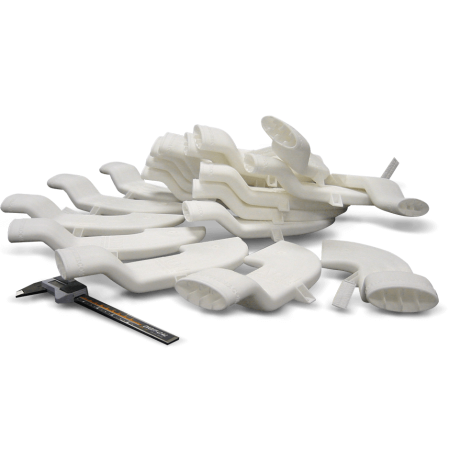The Rapid Prototyping Center at Briggs & Stratton has been using Selective Laser Sintering (SLS) 3D printing since 2015 when it acquired a 3D Systems' SLS printer. Prior to bringing SLS in-house, the global engine, yard, home, and international products manufacturer used machining, external services, and a variety of other in-house printing technologies to meet its prototyping needs. Buying an SLS printer has transformed Briggs & Stratton’s prototyping capabilities, introducing new levels of throughput, durability, and accuracy to unlock unprecedented productivity in product development. Briggs & Stratton has also realized significant cost savings since bringing SLS in-house.
SLS accelerates new product development
Briggs & Stratton’s SLS prototyping applications run the gamut from blower housings and fuel injector systems, to cyclonic air cleaning systems, mufflers and intake manifolds, just to name a few. In addition to proof-of-concept prototyping for nearly all parts, Briggs & Stratton designers include certain SLS parts on engine fit-ups for early insights into design performance, assembly, and interferences.
The cost-effectiveness of 3D Systems’ SLS has made the technology a winning addition for Briggs & Stratton management. Yet the company’s designers unanimously agree the greatest advantage is speed. “The quicker we can get a design in our hands, the sooner we can take next steps,” says Matt Martinek, New Product Development, Briggs & Stratton. “We SLS print just about every part we come up with a new design for.”
SLS durability enables more testing for more applications
While the majority of SLS parts printed at Briggs & Stratton are used for form and fit verification, Michael Dorna, manager of Briggs & Stratton’s Rapid Prototyping Center, estimates that 30-40% of SLS part orders are tested for functionality. “With SLS, we get the benefit of tough, durable parts that can also be detailed,” says Dorna.
Citing an extreme application example, Dorna says he received a part request for an SLS printed and epoxy-sealed intake manifold: “The next thing I knew I had an order for six more,” he says. “I found out these SLS parts are being used to qualify the design, which means they’re being run on an air-cooled engine for 2000 hours at wide open throttle. That’s a brutal environment, and these parts are holding up.”
Briggs & Stratton currently uses DuraForm® ProX® PA across all of its prototyping applications. DuraForm ProX PA is a durable polyamide 12 nylon material that offers resolution and mechanical properties ideal for complex parts with thin walls or snap fit requirements. Many of the parts that are functionally prototyped using SLS are ultimately injection molded in an ABS plastic or glass-filled nylon, however designer Brian Holzman also reports great success using SLS to prototype sheet metal parts. “A lot of the sheet metal parts are 0.8-1 millimeter thick, and the DuraForm material does an awesome job on those,” he says. “It’s durable and flexible, so it’s conducive to thinner parts.”
High throughput helps meet high demand
Across the board, Briggs & Stratton designers praise the speed of SLS because fast access to parts enables them to efficiently move their projects forward with confidence. The ability to stack parts within an SLS build enables higher throughput, making it possible to build more parts at once and keep up with the continual demand for more parts.
By no longer outsourcing a high volume of parts, it is no longer necessary to introduce uncontrolled wait time between part requests and fulfillment. The annual cost savings are also considerable, says Dorna: “Every time a printer is running we are saving resources.”
Mechanical designer Jonathan Tyznik works in Briggs & Stratton’s Research & Development group and estimates that depending on where he is in development he requests an average of 1-2 to 12-15 SLS parts a week. Designer Casey Groh says: “I’ve easily requested a hundred parts or more for the current project I’m working on.”
Early design confidence saves time, lowers cost
According to Bob Johnson, a Briggs & Stratton designer for over 30 years, a coat of spray paint is all it takes to give the SLS parts a close resemblance to their final molded counterparts, and the SLS parts perform similarly as well. “We run the SLS parts through the same tests that we would a regular component,” says Johnson. “They’re very similar to the parts that we’re going to get for production, so we’re pretty confident about the tests we do.”
To ensure confidence in final production materials, Briggs & Stratton does not exclusively rely on SLS parts for final pre-production testing, but Johnson says using SLS for certain testing, such as performance and airflow, allows the company to accelerate its validation process. “We can get a really big jump on final testing by using SLS in development. By the time we get the molded parts, most issues have already been solved,” he says. “It definitely saves us time and money, and has improved our time to market.”
Self-contained system works in machine shop environment
According to Dorna, initial encouragement to get an SLS printer came from Briggs & Stratton’s VP of Global Innovation. Dorna says he was hesitant to acquire a powder-based machine and risk exposing his other equipment with contaminants, but the system architecture of 3D Systems’ SLS solution changed his mind. “When I found out 3D Systems had a system that was self-contained, less dusty, and had no manual mixing, I was convinced it was the way to go,” says Dorna.
Now a happy convert, Dorna says Briggs & Stratton’s experience has been positive from the start: “I was impressed with the initial set up and training, and all communication with 3D Systems has been quick and professional.”
Are you interested in SLS to accelerate your innovation? Download 3D Systems’ SLS eBook for more information on our solutions and applications.
